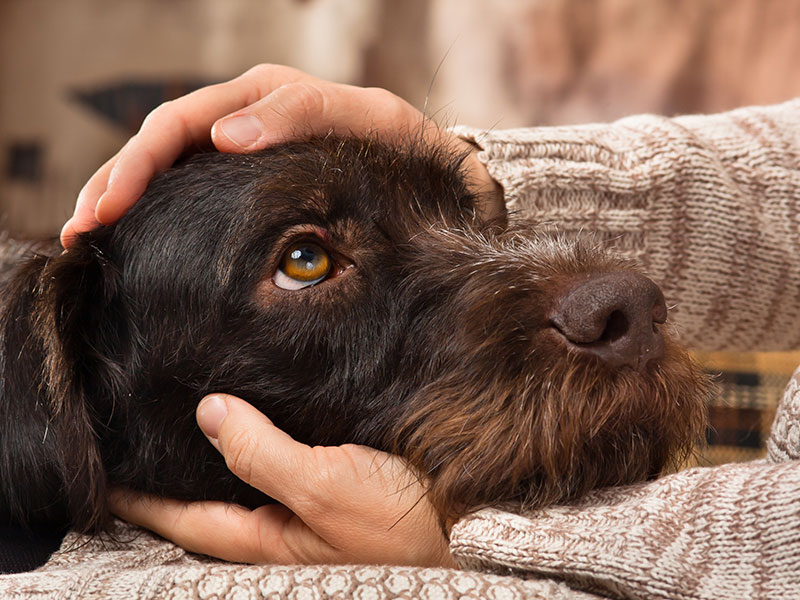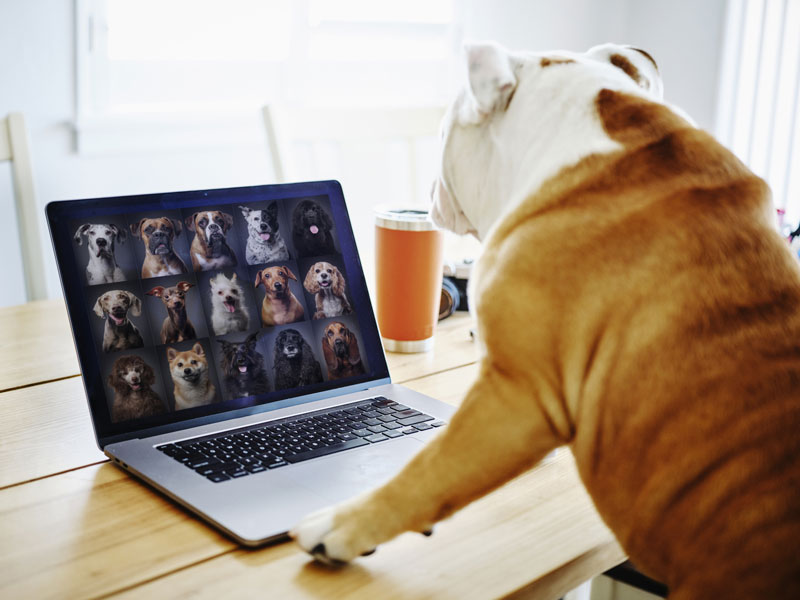
Despite being less routine-based than cats, dogs are still vulnerable to sudden changes in their environment.
Any change in household dynamics can cause a behavior shift in dogs, especially if the new normal results in them spending more time with their owners. With many of us now working remotely, isolating, or otherwise swapping trips out of the house for staying on the couch, rates of canine attachment issues are spiking. Here are some strategies for dealing with newly onset separation anxiety in your dog.
What is hyper-attachment/separation anxiety in dogs?
Canine separation anxiety is a common condition, often seen in working breeds such as retrievers and shepherds, or in dogs who have lived in more than one home. The condition refers to dogs who become extremely agitated or upset when they’re separated from an owner or fellow pet, due to them having formed unhealthy attachment with that person or animal (otherwise known as hyper-attachment).
The key thing to note about canine separation anxiety is that the amount of time spent apart is not usually a relevant factor. Whether it’s 2 minutes or 2 hours spent alone, a pup suffering from moderate to severe separation anxiety is likely to display a similar reaction. Separation anxiety can even occur when an attached person behaves in ways that a dog doesn’t expect, such as turning away to take a phone call or meeting somebody new at the front door.
The most common behaviors associated with separation anxiety include:
Why are these issues spiking right now?
To say that separation anxiety is on the increase somewhat clouds the fact that separation disorders are among the most common behavioral problem in dogs. Despite how widespread these issues are, the ASPCA currently maintains that there’s no conclusive evidence for exactly why dogs develop separation anxiety.
We do know that past experiences combined with changes to routine play a large role in the development of separation issues. A 2001 study that surveyed 400 pups found a significant association between cases of hyper-attachment and separation anxiety, as well a link between separation anxiety and the past loss of an important person (or animal) in a dog’s life. This may suggest that, once hyper-attachment occurs, dogs are more likely to experience a sense of ‘loss’ when the attached person leaves the room or acts in an unexpected way, triggering an anxiety response.
Hyper-attachment is more likely to occur when dogs (especially those predisposed to attachment issues) experience a sudden increase or decrease in contact with their owner. Finding structured time apart during the pandemic has been difficult for many of us, who may now be working from homes without yard space, spare rooms, or other ways of creating opportunities for alone time.
If you find that you’re spending less and less time apart from your pup, or if you notice your pup following you around the house more than usual (sometimes known as Velcro Dog!) then it’s worth considering the possibility that your pet is forming an unhealthy attachment.

What can owners do?
Striking the right balance of time spent with and without your four-legged friend is often a personal matter, based on the individual personality, upbringing, and breed characteristics of your pup.
All dogs are highly social creatures with a pack mentality. If it was left up to them, they’d spend every hour of every day with you, whether or not it benefited their mental health. So, it’s up to owners to develop planned and scheduled separations, which are long enough to establish independence and reduce hyper-attachment, but not so long that they induce further issues.
Crate training/manufacturing time apart
Dogs thrive in stable environments where they can know what to expect, but a generally daily structure is preferable to a strict routine. In fact, an over-strict routine can actually pre-dispose your pup to anxiety, as it sets up rigid expectations that can cause alarm when broken.
For example, it’s important to feed your dog on a consistent mealtime schedule, but sticking to the exact same feeding time each day may encourage a fixation on that moment, and then panic when feeding time passes without dinner being served. The same goes for other common parts of the day such as leaving the house and returning home in the evening.
The key is to stick to a few daily principles, such as a walk, playtime, and a period of quiet alone time—with the alone time being just as important for your dog’s overall wellbeing as other activities. One well-known way to artificially introduce this alone time is through crate training…
Crate training relies on giving your dog a safe space: somewhere warm, quiet, dark, and comfortable that, while they may not love it, helps them to feel safe and sound. This encourages dogs to take a nap, or to simply accept their crate as a place to wait until their owner is ready for more interaction.
To help make crates more inviting, consider giving your pup a treat or special toy that they only get to play with when inside the crate. Leaving the television or radio playing may also help set a calm atmosphere.
When introducing crating make small, incremental changes to the daily routine. Spending even 10 minutes in the crate should help provide an opportunity for independence-forming behaviors. During crate training, other tasks such as walks and feeding should be kept as regular as possible, so as to avoid a sense of complete change to routine.
If your home can’t accommodate an appropriately sized crate, or if you feel your dog isn’t ready to accept even short periods of crating, it can help to take these same principles and apply them in other areas. For instance:
- If you leave the house regularly, arrive home 5 -10 minutes later than normal to slightly disrupt your dog’s expectations. If you don’t regularly leave the house, ‘crate yourself’ by stepping outside, or closing the door to a room.
- Install a baby gate so that you and your pup can be separated while still remaining within sight. Make sure that your dog’s bed and food are on their side of the gate.
CBD supplementation
Animal studies comparing CBD with other anti-anxiety medications have shown that the non-psychoactive plant extract produces similar effects to common anxiolytic drugs in dogs, such as diazepam. Unlike these anti-anxiety medications, however, CBD doesn’t work through mechanisms that put dogs at risk of nasty side effects.
Despite the fact that CBD is yet to be officially recognized as a proven anti-anxiety treatment, there’s a compelling amount of clinical evidence on CBD’s soothing effects. Some of these tests have occurred in dogs—mostly on CBD’s ability to reduce internal inflammation—but the majority have used mice, rats, and humans as test subjects.
A review of such studies compiled in 2015 found that current research conclusively demonstrates CBD’s efficacy in reducing anxiety behaviors related to a range of anxiety disorders, including PTSD, GAD, PD, OCD, and SAD. A 2011 study on rats also showed that CBD is able to positively affect the fear responses of animals, meaning that CBD helped them to ‘unlearn’ anxiety triggers.
Taking advantage of these characteristics, many owners use CBD extracts to help their dogs transition to new routines. Supplementing with CBD helps dogs to remain calm in panic-inducing situations, so it’s a fantastic way to help them adopt new training mechanisms. Other aids, such as calming pheromones or essential oils like lavender can work in similar ways, providing a great window of opportunity for a more independent routine to become a permanent behavior.



